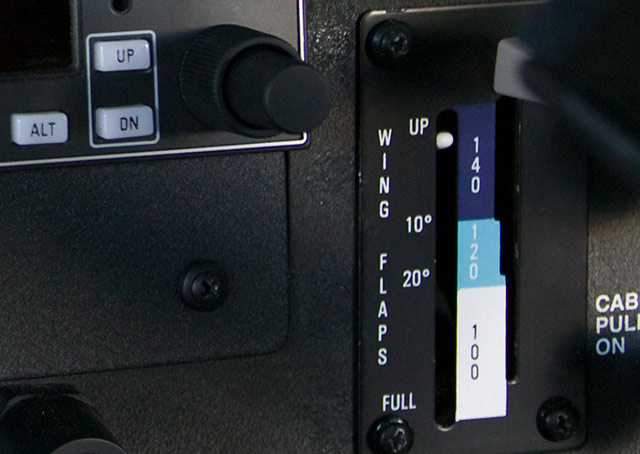
A student pilot is flying the traffic pattern in a Cessna 152. In a well-practiced sequence, the student reduces power to 1,500 rpm when opposite the touchdown zone, holds the aircraft in level flight with gentle back-elevator pressure, and watches for the airspeed to slow to the aircraft’s VFE of 85 knots.
Once the trainer has decelerated to that value—visible at a glance as the top of the white arc on the airspeed indicator, and defined as the "maximum speed permissible with flaps extended"—the student will commence flap extension, eventually concluding the approach with a full-laps landing.
There is another aircraft inbound. The faster Cessna 182S is a few miles out, and has been instructed to enter the left downwind. Slowing from 140 KIAS, the speed is still well above its top-of-the-white-arc airspeed, 100 knots. Nevertheless, the pilot reaches for the flap switch and extends 10 degrees of flaps. Then, when the aircraft has slowed to 120 KIAS, the pilot extends another 10 degrees of flaps.
There is no flaw in the Cessna 182S pilot’s technique. Just as the student pilot in the Cessna 152 was following correct procedure for flap extension, so was the pilot of the larger, high-performance aircraft. The difference in their methods is explained by the manufacturer having provided one VFE for the Cessna 152, and three VFE speeds for the Cessna 182—one each for 10 degrees of flaps, 10 to 20 degrees of flaps, and from 20 degrees to full flaps. This versatility gives the pilot options for managing the aircraft’s wider airspeed range and the descent during the arrival phase.
Color-coding airspeed ranges also helps simplify the management of airspeed and flaps combinations in aircraft with multiple VFE speeds. The flap indicator on the Cessna 182S includes a placard that gives each flap setting’s permitted airspeed range, paired with either dark blue for 10 degrees of flaps, light blue for 10 to 20 degrees, and white for 20 degrees to full flaps.
One characteristic the two aircraft share is that a full-flaps landing configuration extends the airspeed range at the low end several knots below the lower limit of the green arc (which is defined for both aircraft as the normal operating range). Another shared quality is that on a balked landing, or go-around, the pilot should retract the flaps to 20 degrees promptly after power is applied.



